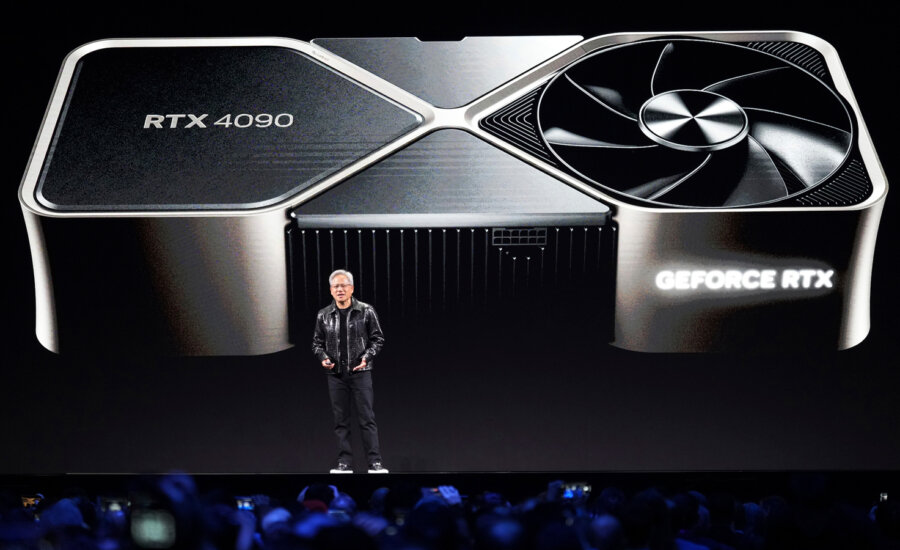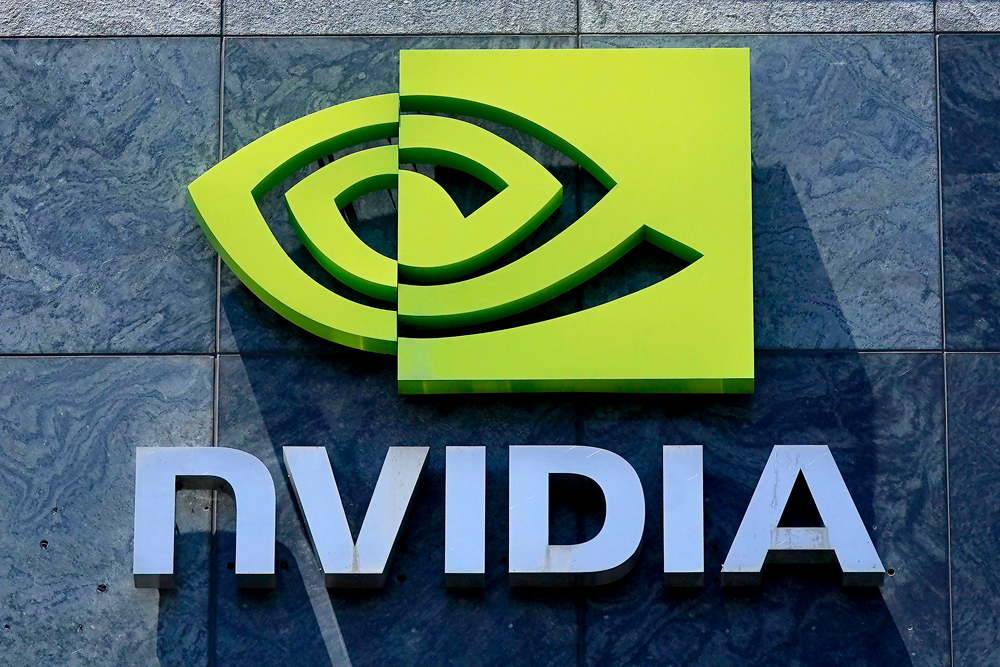Nvidia’s fourth-quarter earnings analysis: revenue up, production up
Nvidia posted another strong quarterly report, and its sales surged in the fourth quarter, thanks to a strong demand for AI chips. Here’s what to know—by the numbers.
Advertisement
Nvidia posted another strong quarterly report, and its sales surged in the fourth quarter, thanks to a strong demand for AI chips. Here’s what to know—by the numbers.

Nvidia on Wednesday reported a surge in fourth-quarter profit and sales as demand for its specialized Blackwell chips, which power artificial intelligence systems, continued to grow, sending the company’s stock higher after hours. For the three months, that ended Jan. 26, the tech giant based in Santa Clara, California, posted revenue of USD$39.3 billion, up 12% from the previous quarter and 78% from one year ago. Adjusted for one-time items, it earned USD$0.89 a share. (All values are in U.S. currency.)
“Demand for Blackwell is amazing as reasoning AI adds another scaling law—increasing compute for training makes models smarter and increasing compute for long thinking makes the answer smarter,” Nvidia Founder Jensen Huang said in a statement.
Nvidia has ramped up the massive-scale production of Blackwell AI supercomputers, Huang said, “achieving billions of dollars in sales in its first quarter.”
“AI is advancing at light speed as agentic AI and physical AI set the stage for the next wave of AI to revolutionize the largest industries,” he said. Wednesday’s earnings report topped Wall Street expectations. Analysts had been expecting adjusted earnings of 85 cents a share on revenue of $38.1 billion, according to FactSet. Nvidia reported net income of $22.06 billion in the fourth quarter, beating analysts’ predictions of $19.57 billion. The tech giant expected sales to continue to grow, forecasting revenue of around $43 billion for the first quarter of fiscal 2026.
Data centre sales, which account for much of Nvidia’s revenues, were a core part of that uptick—fourth-quarter revenue was $35.6 billion, up 93% from one year ago.
The growth in the data centre market comes as President Donald Trump has talked up a joint venture investing up to $500 billion for infrastructure tied to AI through a new partnership formed by OpenAI, Oracle and SoftBank.
The Stargate project will start building out data centres and the energy generation needed for the further development of AI, according to the White House. Nvidia is a partner in that project.

Build your retirement savings with 2.00% interest, tax-deferred contributions and zero fees.

Earn a guaranteed 3.5% in your RRSP when you lock in for 1 year.

See our ranking of the best RRSP accounts and rates available in Canada.
MoneySense is an award-winning magazine, helping Canadians navigate money matters since 1999. Our editorial team of trained journalists works closely with leading personal finance experts in Canada. To help you find the best financial products, we compare the offerings from over 12 major institutions, including banks, credit unions and card issuers. Learn more about our advertising and trusted partners.
On an earnings call Wednesday afternoon, Nvidia Chief Financial Officer Colette Kress said that fourth-quarter Blackwell sales exceeded the company’s expectations. “We delivered $11 billion of Blackwell architecture revenue in the fourth quarter of fiscal 2025, the fastest product ramp in our company’s history,” Kress said. “Blackwell sales were led by large cloud service providers which represented approximately 50% of our data centre revenue.”
The poster child of the AI boom, Nvidia has grown into the second-largest company on Wall Street—it is now worth over $3 trillion—and the stock’s movement carries more weight on the S&P 500 and other indexes than every company except Apple. Two years ago, Nvidia’s market value was below $600 billion.
Nvidia and other companies benefiting from the AI boom have been a major reason the S&P 500 has climbed to record after record recently, with the latest coming last week.
Their explosion of profits has helped to propel the market despite worries about stubbornly high inflation and possible pain coming for the U.S. economy from tariffs and other policies of President Donald Trump. But those tariffs are still “an unknown,” Kress said, until Nvidia can better understand what the Trump administration’s plan is. “We are awaiting,” she said, adding that the company would follow any export controls or tariff rules.
The fourth-quarter earnings are the company’s first report since Chinese company DeepSeek boasted it had developed a large language model that could compete with ChatGPT and other U.S. rivals, but was more cost-effective in its use of Nvidia chips to train the system on troves of data.
The frenzy over DeepSeek caused $595 billion in Nvidia’s wealth to vanish briefly. But the company in a statement commended DeepSeek’s work as “an excellent AI advancement” that leveraged “widely-available models and compute that is fully export control compliant.”
“DeepSeek R1 has ignited global enthusiasm,” Huang said on Wednesday’s earnings call. “It’s an excellent innovation, but even more importantly, it has open-sourced a world-class reasoning AI model. Nearly every AI developer is applying R1, or chain of thought and reinforcement learning techniques like R1, to scale their models’ performance.”
Speaking to investors, Huang said the “next wave” of AI is coming with “agentic AI for enterprise, physical AI for robotics and sovereign AI as the different regions build out their AI for their own ecosystems.”
“We’re in the centre of much of this development,” Huang said.

Wall Street once again fixated on an earnings report from Nvidia, the main player in the artificial intelligence mania. The chipmaker reported earnings after the bell Wednesday that topped analyst forecasts, and shares added 2% in after-hours trading, perhaps indicating that Wall Street quietly hoped for even better results.
This is Nvidia’s first earnings report since a Chinese upstart, DeepSeek, upended the artificial-intelligence industry by saying it has developed a large language model that can compete with big U.S. rivals without having to use the most expensive chips. Nvidia’s market value saw a one-day drop of nearly $600 billion after the news came out.
Here’s a look at Nvidia, by the numbers.
Nvidia’s total market value as of the close Wednesday, before the release of its earnings report. That’s second in the S&P 500 behind Apple ($3.611 trillion). Microsoft is third with a market value just below $3 trillion ($2.972 trillion). Two years ago, Nvidia’s market value was below $600 billion.
The one-day drop in Nvidia shares on Jan. 27 after DeepSeek’s revelation called into question all the spending Wall Street had assumed would go into not only Nvidia’s chips but also the ecosystem that’s built around the AI boom. The stock rose more than 170% in 2024.
Nvidia’s revenue for the fourth quarter, easily topping Wall Street’s estimate and up 78% from last year’s fourth quarter.
Nvidia’s revenue for the fiscal year that ended in January 2025. That was more than double its revenue for fiscal 2024 and more than four times its receipts the year before that.
That’s approximately how much of the S&P 500’s gain for last year could be attributed to Nvidia alone, according to S&P Dow Jones Indices. By comparison, Amazon accounted for about 6% of the gain. Nvidia replaced Intel in the Dow Jones Industrial Average in November.
That’s how many dozen eggs one could buy with Nvidia’s market value of $3.215 trillion, using the average price of $4.95 per dozen for January from the Federal Reserve. Egg prices have spiked due to an outbreak of bird flu, and supplies of eggs have run short in some areas.
Share this article Share on Facebook Share on Twitter Share on Linkedin Share on Reddit Share on Email